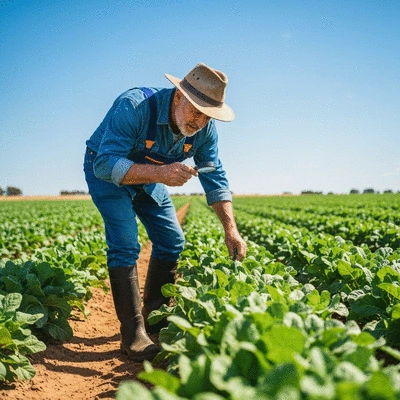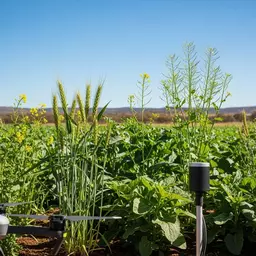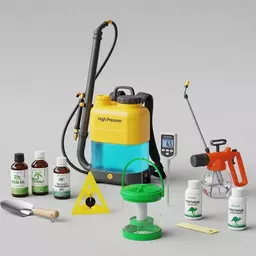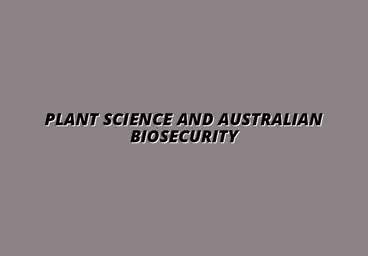Pest Management Costs for Farmers

In the intricate world of Australian agriculture, the battle against pests is not merely a matter of inconvenience; it directly impacts farmers' livelihoods and the economy. With substantial financial implications and sustainability at stake, understanding pest management is crucial. Here's what you'll learn from exploring this vital topic.
What You Will Learn
- Pest animals and weeds impose significant direct costs, including damage control and increased labor expenses for farmers.
- Production losses due to pests can lead to reduced crop yields and diminished income, threatening food security.
- Key pest species, such as feral pigs and wild dogs, require tailored management strategies to mitigate their economic impacts.
- Integrated Pest Management (IPM) offers an effective framework for balancing costs and ensuring long-term sustainability in pest control.
Economic Burden of Pests on Australian Agriculture
The visual below illustrates the multifaceted financial impact of pest animals and invasive weeds on Australian farmers, highlighting key cost areas and specific pest challenges.
Financial Burden Categories
- Direct Damage Costs
- Increased Labor Costs
- Loss of Crop Value
- Production Losses
Pests affect profitability through direct costs, labor, and reduced yields.
Key Pest Species & Impacts
- Feral Pigs: Crop/Infrastructure Damage
- Wild Dogs: Livestock Threats
- Invasive Weeds: Reduced Crop Yields
Specific pests like feral pigs, wild dogs, and weeds cause unique and significant agricultural problems.
Pest Management Solutions
- Cost-Effectiveness Analysis
- Integrated Pest Management (IPM)
- Investment in Training & Technology
Effective strategies like IPM balance costs and environmental benefits for long-term sustainability.
Recommendations for 2025
- Invest in Training & Expertise
- Engage with Local Bodies
- Monitor & Adapt Practices
Proactive, collaborative approaches are key to navigating future pest management challenges.
Understanding the Economic Impact of Pest Management for Australian Farmers
As we delve into the economic challenges faced by Australian farmers, it's crucial to understand the profound financial burden posed by pest animals and invasive weeds. The impact of these pests extends far beyond mere frustration; it directly affects the viability of our agricultural systems. From production losses to inflated control costs, the stakes are high, and the consequences ripple through our economy. For more details on effective strategies, explore sustainable pest control in Australia.
In my journey through the world of sustainable agricultural practices, I've witnessed firsthand how pest management can define a farm's success or failure. With that in mind, let's explore the intricate relationship between pests and agricultural economics in Australia.
The Financial Burden of Pest Animals and Weeds in Australian Agriculture
Pest animals and weeds create a substantial financial burden on farmers, impacting both their operations and profitability. These pests can lead to direct costs associated with damage control, lost yields, and necessary preventive measures. This burden is felt most acutely in the following ways:
- Direct Damage Costs: Farmers often spend significant amounts on pest control and recovery efforts.
- Increased Labor Costs: Dealing with pest invasions requires additional labor, which can strain budgets.
- Loss of Crop Value: The presence of pests can diminish the market value of crops, impacting sales.
As we consider these factors, it's evident that addressing pest issues is not just a matter of environmental stewardship; it is a vital economic necessity for farmers striving for sustainability.

Analysis of Direct Costs Associated with Pest Damage
The analysis of direct costs associated with pest damage reveals a stark reality for many farmers. Each pest interaction can lead to a cascade of financial implications. Farmers frequently find themselves allocating resources towards:
- Pest control equipment and chemicals
- Field monitoring and surveillance systems
- Restoration of damaged crops or fencing
This financial strain can take a toll on a farmer's ability to invest in sustainable practices that may enhance long-term productivity.
Production Losses and Their Economic Consequences
Pest damage not only incurs direct costs but also results in significant production losses. When pests strike, farmers face reduced yields and, consequently, diminished income. The economic consequences are profound and can include:
- Long-term declines in crop yields due to soil degradation
- Increased input costs to compensate for losses
- Higher prices for consumers as supply decreases
These production losses pose a serious threat to food security, making it imperative for farmers to seek effective pest management strategies. Understanding understanding biosecurity in Australia can further aid in preventing such losses.
Key Pest Species Affecting Agricultural Productivity
In Australia, several pest species stand out for their devastating impacts on agricultural productivity. Understanding these pests helps farmers tailor their management strategies effectively. Let's take a closer look at some of the most prominent offenders:
- Feral Pigs: These pests cause extensive damage to crops and infrastructure, often requiring complex control strategies.
- Wild Dogs: Known to threaten livestock, wild dogs present significant challenges for farmers aiming to protect their herds.
- Invasive Weeds: Weeds can choke out native vegetation and reduce crop yields, leading to long-term economic costs.
By identifying and addressing these specific threats, farmers can better navigate the complex landscape of pest management.
Feral Pigs: Economic Impacts and Control Challenges
Feral pigs are one of the most notorious pests in Australia, known for their destructive behaviors in agricultural settings. The economic impacts of these animals are staggering, with estimates suggesting they cost the agricultural sector millions each year. Control efforts can be challenging, often requiring:
- Large-scale trapping and culling operations
- Ongoing monitoring efforts to manage populations
- Collaboration between landowners and government agencies
The financial and logistical complexities make managing feral pigs a persistent challenge for farmers across Australia.
Wild Dogs: Threats to Livestock and Farming Operations
Wild dogs pose a direct threat to livestock, leading to substantial losses for farmers. They can result in:
- Increased mortality rates among sheep and cattle
- Increased costs for protective measures, such as fencing
- Emotional distress for farmers witnessing their livestock suffer
As we explore solutions to these challenges, it becomes evident that a comprehensive approach is vital for safeguarding livestock and enhancing farm resilience.
Invasive Weeds: Long-Term Costs to Crop Yields
Invasive weeds can devastate crop yields, resulting in long-term economic consequences for farmers. These weeds not only compete for nutrients and water but also:
- Require increased herbicide applications, driving up costs
- Reduce overall productivity of affected land
- Negatively impact biodiversity and ecosystem services
Addressing weed issues is essential for maintaining healthy ecosystems and supporting sustainable agricultural practices.
Assessing the Economic Viability of Pest Management Solutions
As we consider solutions for pest management, assessing their economic viability becomes paramount. Effective pest management strategies must balance costs with outcomes to ensure farmers can maintain profitability while protecting their crops. Evaluating these options involves:
- Comparative analysis of traditional versus innovative control methods
- Understanding the long-term impacts of each strategy on yield and quality
- Considering the environmental implications of pest management practices
By thoroughly assessing these factors, farmers can make informed decisions that benefit both their operations and the environment.

Cost-Effectiveness of Various Pest Control Strategies
The cost-effectiveness of pest control strategies varies widely, depending on the pest in question and the methods employed. Farmers must weigh the costs of:
- Preventive measures against potential losses
- Labor and resource allocation for different control techniques
- The long-term sustainability of the chosen approach
By prioritizing cost-effective solutions, farmers can enhance their resilience and operational efficiency.
Financial Analysis of Integrated Pest Management (IPM) Approaches
Integrated Pest Management (IPM) offers a promising avenue for farmers seeking sustainable pest solutions. By combining multiple control tactics, IPM aims to minimize costs while maximizing effectiveness. Conducting a financial analysis of IPM involves assessing:
- Initial investment versus long-term savings
- Potential yield improvements linked to reduced pest pressure
- Environmental benefits that may translate into cost savings
Ultimately, adopting an IPM approach not only protects crops but also aligns with the broader goals of sustainability and resilience within Australia's agricultural landscape. Further insights into agricultural resilience can be found by exploring genetic innovation in sustainable farming.
Pro Tip
Did you know? Implementing precision agriculture techniques can significantly enhance pest management efficiency. By utilizing data-driven tools such as GPS and drones, farmers can precisely target pest populations, reducing unnecessary chemical applications and minimizing costs. This not only protects crops but also promotes environmental sustainability!
Conclusions on Cost-Benefit Analysis for Australian Farmers
As we reflect on the intricate relationship between pest management strategies and their economic impact on Australian agriculture, it's clear that understanding these dynamics is crucial. The financial burden of pests can be staggering, affecting not only individual farmers but also the broader agricultural sector. Throughout this exploration, key insights have emerged regarding how effective pest management can enhance productivity and sustainability.
One significant takeaway is that adopting integrated pest management (IPM) approaches offers a balanced solution. By combining various strategies, farmers can mitigate costs while effectively controlling pest populations. It's essential for farmers to stay informed about the latest techniques and technologies, ensuring that their pest management practices evolve alongside emerging challenges.
Summarizing Key Insights on Economic Impact and Management Strategies
To encapsulate our findings, here are several key insights regarding the economic impact of pest management:
- Understanding Costs: Direct costs from pest damage significantly affect farm profitability.
- Species-Specific Impacts: Different pests present unique challenges and can affect various sectors of agriculture.
- Innovative Solutions: Technology, such as AI and IoT, plays a pivotal role in modern pest management strategies.
- Long-Term Viability: Sustainable methods, particularly IPM, provide both ecological and economic benefits.
By recognizing these factors, farmers can make informed decisions that not only address immediate pest issues but also support long-term agricultural resilience.
Recommendations for Farmers: Navigating Pest Management in 2025
As we look ahead to the year 2025, I encourage farmers to adopt proactive approaches to pest management. Here are some recommendations based on our findings:
- Invest in Training: Stay updated on the latest pest management techniques and technologies.
- Engage with Experts: Collaborate with local agricultural bodies and researchers to share knowledge and resources.
- Embrace Sustainability: Explore integrated pest management strategies that contribute to environmental health.
- Monitor and Adapt: Regularly assess pest populations and the effectiveness of control methods to ensure ongoing success.
By implementing these strategies, farmers can enhance their ability to navigate the evolving landscape of pest management while safeguarding their livelihoods.
Encouraging Action and Further Exploration
Resources for Farmers: Where to Find More Information and Support
If you're seeking further resources to improve your pest management practices, there are numerous avenues to explore. Organizations such as:
- The Australian Pesticides and Veterinary Medicines Authority (APVMA)
- Local agricultural extension services
- University research programs focused on sustainable agriculture
These entities provide valuable information and tools that can help farmers stay informed and effective in their approaches to pest management.
Call to Action: Engaging with Local Agricultural Bodies for Effective Pest Management Solutions
It’s essential to engage with local agricultural bodies to foster effective pest management solutions. By connecting with these organizations, farmers can benefit from shared expertise and resources. This collaboration can enhance the overall effectiveness of pest control efforts in our communities.
Leveraging Community Support for Sustainable Agriculture Practices
Moreover, don’t underestimate the power of community support! Engaging with fellow farmers and agricultural professionals can provide insights and encouragement, driving collective efforts towards sustainable agricultural practices. Together, we can create a resilient future for Australia’s agricultural landscape. Let’s take action now for a better tomorrow!
Frequently Asked Questions (FAQs)
- What are the main financial burdens pests impose on Australian farmers?
- Pests create significant financial burdens through direct damage costs, increased labor expenses for control efforts, and loss of crop value due to reduced yields and diminished marketability.
- Which key pest species are most problematic for Australian agriculture?
- Key pest species include feral pigs, which cause extensive crop and infrastructure damage; wild dogs, threatening livestock; and invasive weeds, which reduce crop yields and require costly management.
- What is Integrated Pest Management (IPM) and why is it important?
- Integrated Pest Management (IPM) is a strategy that combines multiple control tactics to minimize pest impact while balancing costs and environmental sustainability. It's important for long-term effectiveness and reducing reliance on single control methods.
- How can farmers assess the economic viability of different pest control strategies?
- Farmers can assess economic viability by conducting a comparative analysis of traditional versus innovative control methods, understanding the long-term impacts on yield and quality, and considering the environmental and financial implications of each strategy.
- What are some recommendations for farmers to navigate pest management in the future?
- Recommendations include investing in training and staying updated on new techniques, engaging with agricultural experts and local bodies, embracing sustainable IPM strategies, and regularly monitoring and adapting practices for ongoing success.
Recap of Key Points
Here is a quick recap of the important points discussed in the article:
- Understanding Costs: Direct costs from pest damage significantly affect farm profitability.
- Species-Specific Impacts: Different pests present unique challenges and can affect various sectors of agriculture.
- Innovative Solutions: Technology, such as AI and IoT, plays a pivotal role in modern pest management strategies.
- Long-Term Viability: Sustainable methods, particularly integrated pest management (IPM), provide both ecological and economic benefits.
- Proactive Approaches: Farmers are encouraged to invest in training, engage with experts, and monitor pest populations for ongoing success.
Popular Posts
 As the agricultural landscape in Australia evolves, the role of genetic innovation tools becomes inc
As the agricultural landscape in Australia evolves, the role of genetic innovation tools becomes inc
 As the agricultural landscape in Australia faces mounting challenges, understanding effective crop p
As the agricultural landscape in Australia faces mounting challenges, understanding effective crop p
 As Australia faces growing agricultural challenges, the significance of biosecurity cannot be overst
As Australia faces growing agricultural challenges, the significance of biosecurity cannot be overst
 As we delve into the intricate world of biosecurity, consider this: the health of Australia’s ecos
As we delve into the intricate world of biosecurity, consider this: the health of Australia’s ecos
